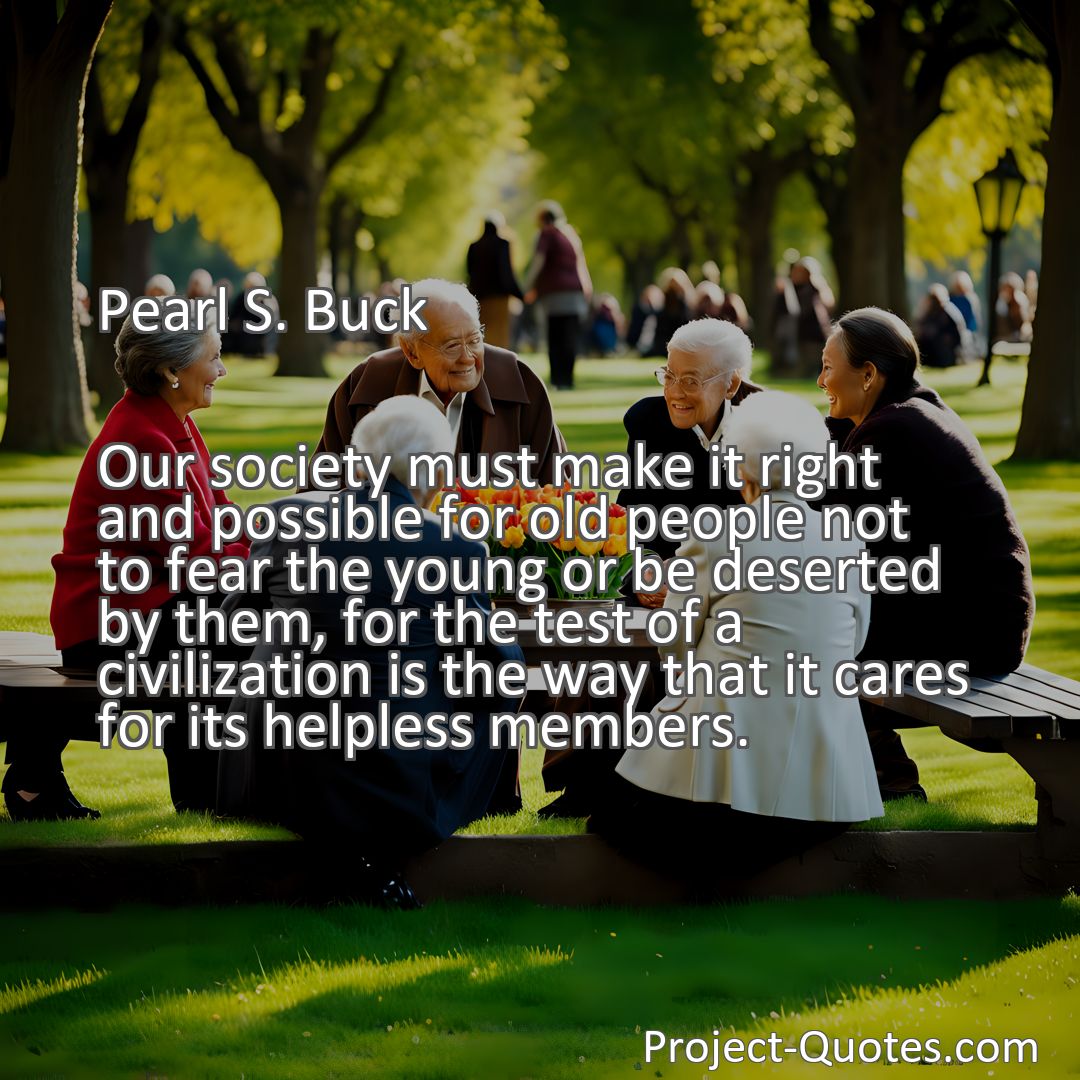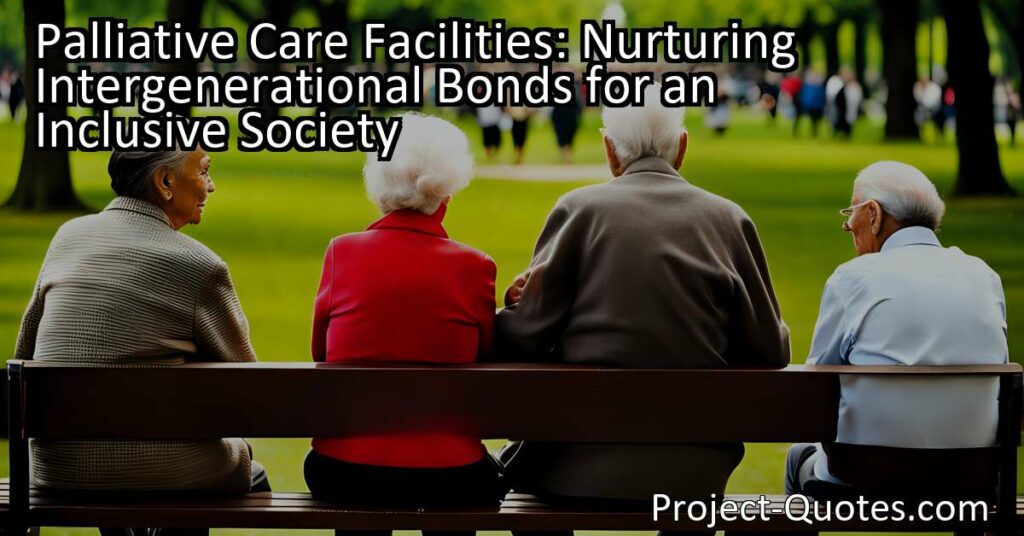Our society must make it right and possible for old people not to fear the young or be deserted by them, for the test of a civilization is the way that it cares for its helpless members.
Pearl S. Buck
Palliative Care Facilities: Nurturing Intergenerational Bonds for an Inclusive Society In a society where the elderly are not abandoned or feared, intergenerational bonds are crucial. Pearl S. Buck challenges us to create a compassionate society that supports and cherishes its aging citizens. By breaking stereotypes, promoting empathy, and providing age-friendly environments, we can build a civilization where the young and old coexist harmoniously.
Table of Contents
- 1 Our society must make it right and possible for old people not to fear the young or be deserted by them, for the test of a civilization is the way that it cares for its helpless members.
- 2 Pearl S. Buck
- 3 Meaning of Quote – Our society must make it right and possible for old people not to fear the young or be deserted by them, for the test of a civilization is the way that it cares for its helpless members.
- 4 Freely Shareable Quote Image
- 5 Related
Meaning of Quote – Our society must make it right and possible for old people not to fear the young or be deserted by them, for the test of a civilization is the way that it cares for its helpless members.
Picture this: a society where the elderly no longer fear the younger generations and are not abandoned by them. A society where the measure of civilization lies in how it cares for its most vulnerable members. This profound notion was eloquently expressed by the renowned American writer Pearl S. Buck. In her quote, Buck highlights the importance of nurturing intergenerational bonds and creating a compassionate society that supports its elderly citizens.
The fabric of any civilization is woven by the collective actions and values of its people. A society thrives when its members exhibit empathy and extend a helping hand to those who need it the most. But what happens when its elderly citizens, who have contributed so much to its development, feel isolated, marginalized, or even abandoned? Buck challenges us to ponder this question.
In an ideal society, the young and the old coexist harmoniously. They find common ground and forge meaningful connections, fostering a sense of unity and solidarity. Rather than fearing the younger generation, the elderly should be able to embrace the future with hope and confidence. By creating an environment where elders are respected and valued, we can ensure that they feel supported and cherished, free from the burden of worry or fear.
When we think of a civilization that cares for its helpless members, images of nurseries, retirement homes, and palliative care facilities may come to mind. While these institutions may serve a necessary purpose, Buck’s message transcends the physical spaces designated for the elderly. It challenges us to look beyond the surface and delve into the core values and attitudes that permeate our society.
Creating a society where the elderly are not only cared for but also actively included and engaged requires a multidimensional approach. It involves breaking down stereotypes and dispelling ageist attitudes that perpetuate the notion of older adults as burdensome or insignificant. We must encourage intergenerational interactions, promoting empathy, understanding, and mutual respect between the young and the old.
Intergenerational programs and initiatives offer a powerful avenue to bridge the gap between different age groups. Schools can partner with retirement communities, facilitating interactions between students and elders, fostering a sense of community and connection. Through conversations, shared activities, and mentorship opportunities, both generations can learn from and enrich each other’s lives.
Older adults possess a wealth of knowledge and experience that, when shared with the younger generation, can shape their perspectives and values. The wisdom and life lessons gained over decades can serve as a guiding light, providing invaluable insights to the younger members of society. Conversely, the vitality, energy, and fresh perspectives of the young can invigorate the lives of the elderly, instilling a sense of purpose and renewed enthusiasm.
Furthermore, creating inclusive spaces and designing age-friendly cities is paramount in creating an environment where the elderly can actively participate in society. Accessible public infrastructure, such as ramps, elevators, and well-designed urban planning, enables older adults to navigate their surroundings comfortably, ensuring they remain connected to their communities. By providing safe and accessible public transportation options, we can alleviate the potential isolation that may otherwise befall older individuals.
In addition to physical accessibility, it is crucial to address the psychological well-being of our aging population. Loneliness and social isolation can have detrimental effects on mental health, leading to a decline in cognitive abilities and overall functioning. Therefore, fostering social connections and supportive networks is vital. Community centers, senior clubs, and volunteer organizations can serve as meeting points for elders, allowing them to engage in activities that nurture their interests and maintain a sense of purpose.
Recognizing the importance of significant relationships with family and friends, we must encourage younger generations to remain connected to their elderly relatives. Grandparents, for instance, play a significant role in shaping family values, passing down traditions, and providing emotional support. By fostering these intergenerational bonds, we reinforce the idea that older individuals are an integral part of our lives, deserving of respect, love, and care.
As our society continues to evolve, it is imperative that we make concerted efforts to create an inclusive and compassionate environment for all. This includes recognizing the invaluable contributions of the elderly and ensuring that they do not fear being abandoned or forgotten. By manifesting a genuine concern for our helpless members, we epitomize the essence of true civilization.
In conclusion, Pearl S. Buck’s poignant quote reminds us of our responsibility to care for the vulnerable members of our society, especially the elderly. Building a civilization that eschews the fear and abandonment of its older citizens demands empathetic actions, intergenerational bonds, and age-friendly environments. By embracing these principles, we can pave the way towards a society where the young and old coexist harmoniously, fostering a civilization that stands tall in its dedication to the well-being of all its members.
I hope this quote inspired image brings you hope and peace. Share it with someone who needs it today!


